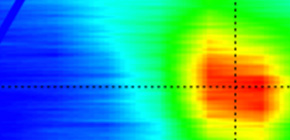
Electronic structure to open the door to development of next generation devices
Dawn of the era of "strong correlation spintronics" on a topological stage
Miniaturization and performance limits of silicon devices have become imminent problems, leading to the anticipation of next-generation devices.
An electron has two degrees of freedom, charge and spin. Humans have prospered through “electronics,” which controls one of these degrees: charge. Now “spintronics,” which controls both charge and spin, has been gathering attention as key to the development of future devices to lead to further prosperity of humankind.
In most matter, the direction of the axis of this spin and the direction of the electron’s movement are not related nor synchronized, making application to devices difficult. On the other hand, in new substances discovered in recent years such as topological insulators (2007) and Weyl semimetals (2015), the spin of electrons is determined spontaneously in correspondence with the direction of the movement of the electron itself. That is, a flow of electrons with the same spin direction, referred to as a pure spin current , flows in such substances, and the application of electrons containing this property to devices is highly anticipated.
A research group led by Assoc. Prof. KONDO Takeshi , Assoc. Prof. NAKATSUJI Satoru , and Prof. Shik Shin of the Institute for Solid State Physics at the University of Tokyo has begun research on development of matter with new functions by combining pre-existing matter such as topological insulators and Wyle semimetals with strong electron correlations .
Now, collaboration with Assoc. Prof. MATSUNAMI Masaharu of Toyota Technological Institute, Prof. KIMURA Shin-ichi of the Graduate School of Frontier Biosciences at Osaka University and Assoc. Prof. ONO Kanta and Prof. KUMIGASHIRA Hiroshi of the Institute of Materials Structure Science, High Energy Accelerator Research Organization has led to the discovery of a new electron state in pyrochlore iridate (Pr 2 Ir 2 O 7 ), a key to uncharted matter development..
This group has established guidelines, so to speak, for taming strongly-correlated electrons, which violently repel one another by nature (i.e. electrons strongly interrelate each other in materials with high electron density). Thereby, we can expect to see an era of “spintronics on strong correlation,” with this new topological state as the stage.
Abstract
Strong spin–orbit coupling fosters exotic electronic states such as topological insulators and superconductors, but the combination of strong spin–orbit and strong electron–electron interactions is just beginning to be understood. Central to this emerging area are the 5d transition metal iridium oxides. Here, in the pyrochlore iridate Pr2Ir2O7, we identify a non-trivial state with a single-point Fermi node protected by cubic and time-reversal symmetries, using a combination of angle-resolved photoemission spectroscopy and first-principles calculations. Owing to its quadratic dispersion, the unique coincidence of four degenerate states at the Fermi energy, and strong Coulomb interactions, non-Fermi liquid behaviour is predicted, for which we observe some evidence. Our discovery implies that Pr2Ir2O7 is a parent state that can be manipulated to produce other strongly correlated topological phases, such as topological Mott insulator, Weyl semimetal, and quantum spin and anomalous Hall states.
To learn more about this research, please view the full research report entitled " Quadratic Fermi Node in a 3D Strongly Correlated Semimetal " at this page of the Nature Communications website.

Related link
- Photophysics Laboratory (Kimura Lab) , Department of Physics, Graduate School of Frontier Biosciences, Osaka University

